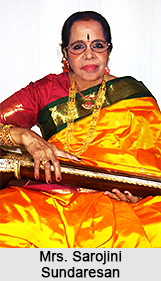Leela Rammohan Rao at the tender age of five years was inducted to the domain of Bharatnatyam. At that time she was residing in Bangalore. Afterward she moved to Madras (presently known as Chennai) and received direct training from the legendary master, Padmasri Natyakala Kesari Late Sri Vazhuvoor Ramiaih Pillai.
 Later on Leela was admitted to the Kathumannar Muthukumara Pillai school and came under the supervision of Kalaimamani Sri Kunjidapadam Pillai, after the death of Sri Ramiaih Pillai. Several margams that were pieces of the Tanjuvur Quartet, Leela Rammohan Rao learnt from Sri Kunjidapadam Pillai. She was supremely favored to have experience Sri Kunjidapadam Pillai`s own compositions. Later on Leela gained training from the maestro like Kalaimamani Mrs. K J Sarasa. Mrs. K J Sarasa was an adherent of the doyen Vazhuvoor Ramiaih Pillai. Leela Rammohan Rao mastered the art of Bharatnatyam from a number of eminent and expert teachers. Leela also received training in Abhinaya and Mrs. Anuradha Jaganathan also gave her the adequate training in Abhinaya.
Later on Leela was admitted to the Kathumannar Muthukumara Pillai school and came under the supervision of Kalaimamani Sri Kunjidapadam Pillai, after the death of Sri Ramiaih Pillai. Several margams that were pieces of the Tanjuvur Quartet, Leela Rammohan Rao learnt from Sri Kunjidapadam Pillai. She was supremely favored to have experience Sri Kunjidapadam Pillai`s own compositions. Later on Leela gained training from the maestro like Kalaimamani Mrs. K J Sarasa. Mrs. K J Sarasa was an adherent of the doyen Vazhuvoor Ramiaih Pillai. Leela Rammohan Rao mastered the art of Bharatnatyam from a number of eminent and expert teachers. Leela also received training in Abhinaya and Mrs. Anuradha Jaganathan also gave her the adequate training in Abhinaya.
Leela Rammohan Rao indeed redefined the art of bharatnatyam dance form. She also received the stringent training in music from her mother, Mrs. Sarojini Sundaresan, who also specialized in the laya-rich Alathur style. She also received training in Konnakol (that is the art by means of language depicting Mridangam sollukattus) from the celebrated Mridangam artist Late Sri. M.N Kanadaswamy.
Late Sri. M.N Kanadaswamy has ameliorated her in strengthening the rhythmical aspects of Bharatnatyam. Several critics have appreciated her for her precise and musical translation of the Sollukattus.
Leela Rammohan Rao now does her own choreography for rarefied and well-known compositions after having been trained rigorously by such leading Gurus of the art called Bharatnatyam. Leela has also choreographed several complex pieces of Mrs. Sundaresan and she has represented those compositions in her concerts. Her students under her strict guidance are also exercising these compositions. This gifted composer of Tamil and Hindi music, Leela has composed several songs on Lord Krishna to her credit. Senior dance choreographers and teachers have also taken these compositions for their students and presented in international festivals.
Leela is also a painter and has won honors in solo and joint exhibitions for her paintings on canvas and other forms as well. She has often donated the income from her paintings for many meriting causes of human welfare in developing countries.
Leela is regarded as the Founder & Director of RaagaLaya Foundation USA. This foundation is a center that is consecrated completely to the guidance and execution of Carnatic Music and Bharatnatyam in Florida. Leela Rammohan Rao holds an MBA degree on Finance from one of the top business schools in the UK and also serves as a Fellow Member of the Securities Institute, UK. She has also been the Member of the Association of Investment Management & Research, USA and acts as premier-most professional bodies in the Investment industry. She serves as the President of GoodWin Asset Management Inc., a US based organization, where she lives with her husband.



















